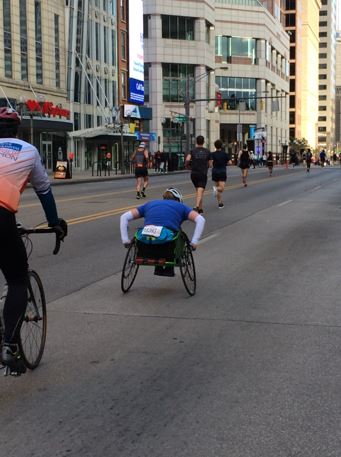Getting Started in Wheelchair Racing by Sarah Werner
 Have you ever watched the athletes zooming around corners at top speed at the Paralympics or marathons and wondered if you too could be a wheelchair racing athlete? It’s easier than you think, and there are lots of organizations and local clubs available to help adaptive athletes of any age get started in the sport of wheelchair racing. This past winter I was looking for an activity that would give me a good cardio workout and that I could participate in with able-bodied friends. I settled on wheelchair racing because it would allow me to “run” with my friends and because there was a local Paralympic club in my city that gave me the resources and training to get started. Now that spring is here, I am out on bicycle paths with all the other runners, getting a great workout and enjoying being outside.
Have you ever watched the athletes zooming around corners at top speed at the Paralympics or marathons and wondered if you too could be a wheelchair racing athlete? It’s easier than you think, and there are lots of organizations and local clubs available to help adaptive athletes of any age get started in the sport of wheelchair racing. This past winter I was looking for an activity that would give me a good cardio workout and that I could participate in with able-bodied friends. I settled on wheelchair racing because it would allow me to “run” with my friends and because there was a local Paralympic club in my city that gave me the resources and training to get started. Now that spring is here, I am out on bicycle paths with all the other runners, getting a great workout and enjoying being outside.
A helpful first step in getting into wheelchair racing is to find a local club or group with a track program. Team USA Paralympics has a club finder (https://www.teamusa.org/US-Paralympics/find-a-club) where you can search for organizations in your area that sponsor adaptive sports. These include local Paralympic clubs and other organizations. In my city we have a Paralympic club that is part of the city’s parks department. They have teams in eight different sports, an adaptive gym, and coaches to help you learn a new sport or skill. Another way to connect with athletes in your area is to find a local wheelchair racing track meet and talk to participants. Athletes are always happy to tell others about how to get involved in adaptive sports.
A common misperception about wheelchair racing is that you have to kneel to use a racing chair. While many top athletes compete in the kneeling position, you’ll find many others at local races and track programs who compete with their feet on a footplate. There are three different cage styles found on racing chairs, only one of which requires you to be in a kneeling position. A V-cage racer is what most athletes start out using because it allows you to sit with your feet in front of you, and to progress to a kneeling position in the future if you choose. It can also be customized so that athletes with a higher level of injury can be positioned more upright, while others with more abdominal function can be more crouched.
One of the biggest perceived obstacles to getting into the sport of wheelchair racing is the high cost of a custom-built racer, which can easily exceed $3,000, a price that is out of reach for many people with disabilities. One option is to buy a used racer from someone who is the same size and disability level as you. This is important because every chair is designed with a particular person in mind. There are also lots of grants available for adaptive athletes; the Challenged Athletes Fund is the most well-known and gives out a large number of grants each year. Disabled Sports USA has a listing of organizations who grant funding in the US, some of which are sport- or injury-specific.
If you are able to be part of a track program at your local Paralympic club, they often have equipment to loan out that can be adjusted to fit you. This is a great way to try it out before needing to invest a lot of money or apply for a grant. Local clubs and teams also may have funds to pay for race entry fees and learning clinics.
The best kinds of trails when you’re just starting out in the sport are rail-trails, or rail lines that have been converted to bike paths. They are for the most part paved and fairly straight with gradual slopes, making them an easy place to learn without having to steer or climb hills too much. The Rails to Trails Conservancy (https://www.railstotrails.org/) has trail maps and other resources to help you find one in your area.
You can track your activity with a bicycle computer, a smart watch or a Fitbit. This is helpful for knowing how far and fast you are going. I really like using the “bike” activity feature on my Fitbit because it tells me my average speed at every part of the run and shows on the map how far I went. The Apple Watch has a wheelchair setting that allows it to specifically track the movement of wheelchair users: https://abilitytools.org/blog/apple-watch-can-help-wheelchair-users-roll-past-their-new-year-fitness-goals/
Signing up for a road race is a good way to motivate yourself towards a set goal. Most large marathons and half marathons have a wheelchair division, sometimes called a pushrim division, and you can indicate that you will be using a racing chair on your registration form. Usually at a road race, wheelchair athletes will start before the runners because we move faster than people on foot, and you might also have bicycle escorts to clear runners from your path when going downhill, since you will be able to reach speeds over 30 mph. Races are a great place to meet other athletes and pick up tips from more seasoned racers.
I had lots of fears when I first started out. I was worried about doing the push-stroke wrong or crashing into something or someone because I wasn’t good at steering, but these are things that begin to come naturally as you get more experience with it. YouTube and the internet are also full of helpful tools for aspiring wheelchair racing athletes wanting to know more about the proper pushing technique, transferring into and out of the racing chair, and even how to unload your racer from the car by yourself. It’s a good idea when getting started in any sport to connect with people in your area that are already involved, but there is a large online community ready to help as well.
So get out there and find your own challenge today!











You must be logged in to post a comment.